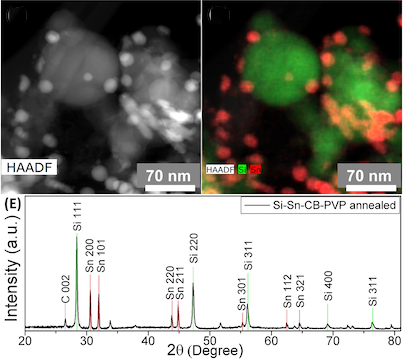Simple Low-Cost Battery Electrode Alternative
Full Description
Background
Silicon continues to be investigated as the next generation anode material because of its high lithiation capacity, abundant availability and non-toxicity. The structural instability of silicon anodes during lithiation, the low electrical conductivity and the formation of an unstable solid electrolyte interphase, leading to a fast capacity fade and poor cycling stability of the electrodes – have hampered increased adoption. An improved formulation of silicon would greatly enhance its use as a replacement for graphite anodes in lithium-ion batteries.
Technology
Prof. Mangolini and his colleagues from the University of California, Riverside have developed a novel silicon-tin nanocomposite that may be used as anodes for lithium-ion batteries. Commercial silicon particles and off-the-shelf additives such as tin dichloride are used due to their low material cost and have shown good performance in both capacity and stability.

(Left) High angle annular dark field image confirming the compositional variation between the large particles and the smaller one decorating the surface of the larger particles. (Right) Elemental mapping corresponding to (Left), confirming that the larger particles are silicon while the smaller ones are tin. (Bottom) XRD pattern for the silicon-tin nanocomposite, confirming the presence of both the silicon and the tin crystalline phases.
Applications
- To replace graphite anodes in lithium-ion batteries for improved battery capacity and stability
- For use in electrochemical energy storage systems
Advantages
The significance benefits of this invention are:
Patent Status
| Country | Type | Number | Dated | Case |
| United States Of America | Issued Patent | 11,152,608 | 10/19/2021 | 2016-350 |
Related Materials
Inventions by Prof. Mangolini
Please review all inventions by Prof. Mangolini and his team at UCR.
Contact
- Venkata S. Krishnamurty
- venkata.krishnamurty@ucr.edu
- tel: View Phone Number.
Other Information
Keywords
coating silicon nanoparticles, anode, silicon-tin nanoparticles, lithium-ion battery, silicon anode, electrochemical energy storage, energy storage
